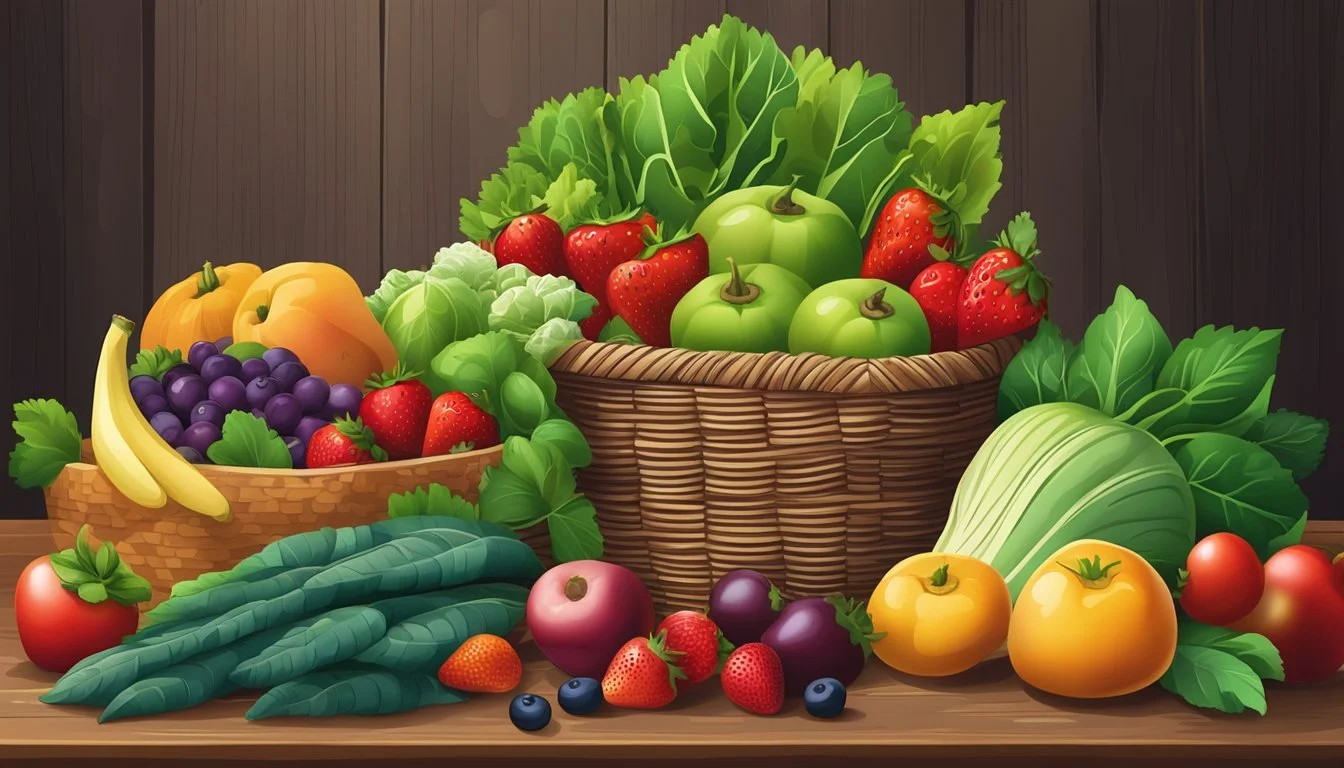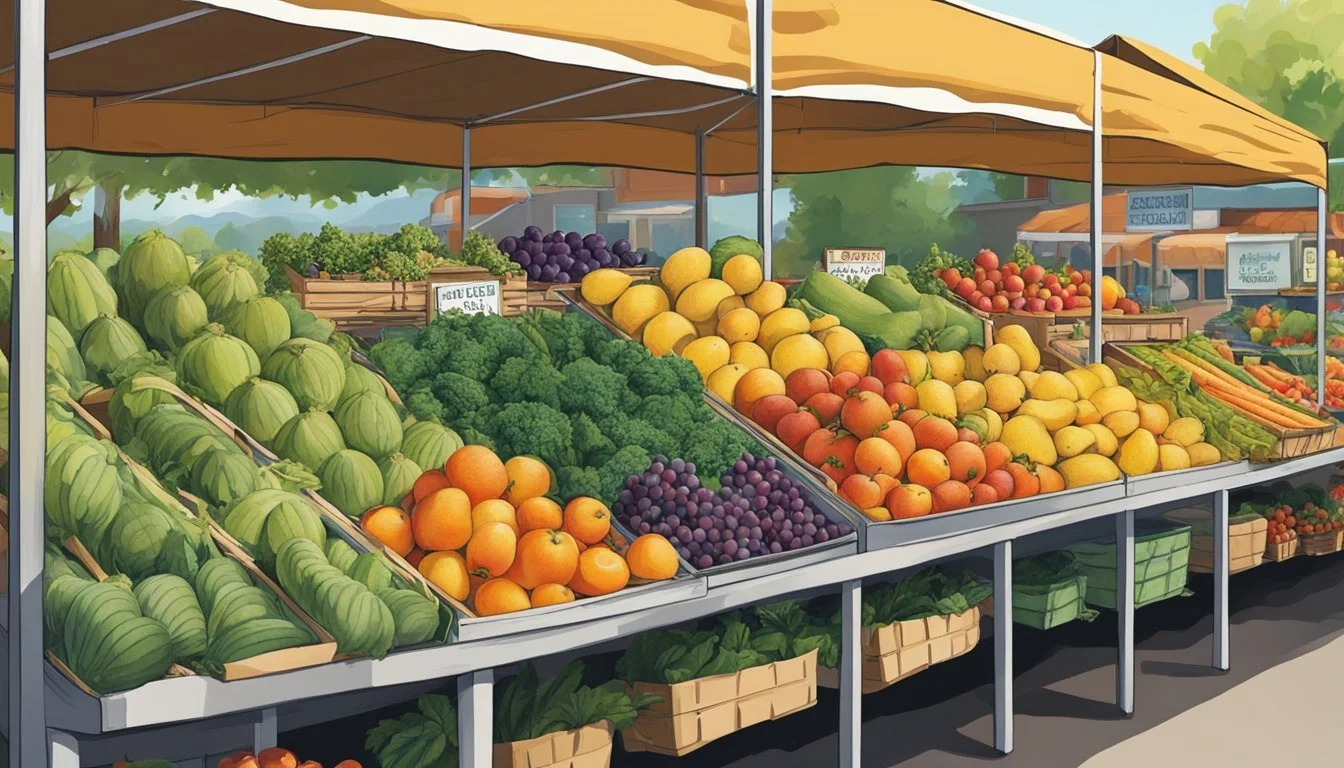Montana Seasonal Fruit & Vegetables in May
A Guide to Fresh Produce
This Article is Part of our Montana Seasonal Fruit & Veg Calendar
In Montana, the arrival of May heralds a shift in the agricultural calendar as the state transitions from the cold, dormant winter months into a period of growth and renewal. This change is marked by the availability of a variety of fresh produce, which begins to emerge in farmers' markets and local gardens. The weather, gradually warming, allows for the early planting and harvesting of certain fruits and vegetables, each cycle deeply influenced by the region's unique climate and seasons.
Seasonal eating in May in Montana means enjoying the early bounty that the state's fertile lands have to offer. Certain crops thrive in the brisk yet brightening days of late spring. Leafy greens such as spinach and kale begin to flourish, offering crisp flavors and nutrients after the long winter. Root vegetables, which are often stored from fall harvests, continue to be available, providing a bridge between seasons as the ground prepares for new growth.
The relatively cool climate of Montana's spring influences not only the type of produce that is available but also its quality. The fresh, clean waters from melting snow and the state's rich soil combine to create ideal conditions for these early fruits and vegetables. Producers and consumers alike eagerly anticipate the fresh flavors of May, knowing that with each passing week, the variety and volume of local produce will increase as the growing season finds its stride.
Spring Harvest in Montana
As the grip of a long winter loosens, May marks the celebration of spring's return in Montana with an abundance of leafy greens and a selection of early season vegetables, beginning the state's progressive harvest period.
Leafy Greens and Herbs
Lettuce: A staple of spring, varieties such as Romaine and Butterhead are harvested, offering crisp textures and fresh flavors. Spinach, known for its versatility, enters the scene with its nutrient-rich leaves. Kale emerges as a hardy choice, and Arugula (how long does arugula last?) provides a peppery note to the state’s salad greens collection. Alongside these, Herbs such as parsley and mint contribute their intense aromas and flavors, elevating dishes prepared with fresh, local produce.
Crop Availability Flavor Profile Lettuce Ready to harvest Crisp, fresh Spinach Ready to harvest Earthy Kale Ready to harvest Slightly bitter Arugula Ready to harvest Peppery Mint & Herbs Ready to harvest Varied
Early Season Vegetables
The arrival of Asparagus (how long does asparagus last?) spearheads the category, signifying one of the first non-leafy vegetables to be picked. Gardeners and farmers eagerly anticipate their arrival for the shoots’ tender texture and subtle, earthy flavor. Peas, both garden and sugar snap varieties, begin to flourish, as do Radishes with their characteristic bite. Green Onions and Rhubarb also join the ensemble of spring harvest, the former contributing a mild, sharp essence to dishes, while the latter offers tartness, often sought after for desserts and jams.
Vegetable Harvest Time Taste and Use Asparagus Early spring Earthy, used in many dishes Peas Mid to late spring Sweet, crisp Radishes Early spring Spicy, crunchy Green Onions Early spring Sharp, mildly intense Rhubarb Early spring Tart, mainly for desserts
As these crops become available, the growing season in Montana is manifesting the region's rich agricultural potential and serving as a prelude to the bountiful summer harvest that follows.
Seasonal Fruits in Early Summer
In May, Montana's early summer greets residents and visitors with a refreshing array of seasonal fruits. As the state shakes off the last vestiges of spring, a variety of berries and stone fruits begin to make their appearance in local markets.
Berries and Stone Fruits
Strawberries: They are among the first to herald the fruit season in Montana. Typically, strawberries become available and reach their peak in this transitional period. One should look for bright red coloring and a sweet aroma, signs of a truly ripe strawberry.
Cherries (how long do cherries last?): Following closely are cherries, which typically ripen towards the end of May or early June. These range from sweet to tart in flavor, and their firmness, plumpness, and deep color are good indicators of quality.
Berries: Besides strawberries, other berries such as raspberries and blackberries start to come into season. These berries are known for their vivid colors and are packed with nutrients. They make excellent additions to salads, desserts, or simply eaten by the handful for a nutritious snack.
Planning and Preparation
As May arrives in Montana, gardeners should focus on understanding the local planting cycles to maximize their harvests. The shift from spring to early summer presents unique opportunities for planting a variety of fruits and vegetables.
Understanding Planting Cycles
Montana's growing season typically gears up in May, with the lingering chance of frost necessitating careful planning. Here's what gardeners should consider:
Seasons & Temperatures: May in Montana is a transitional period where the last frost dates vary significantly across the state. While the warm-season crops are not quite ready to be planted outdoors, preparations for their planting should be underway.
Growing Season: It is crucial for gardeners to recognize that Montana's growing season is relatively short. By May, one should prepare soil and finalize planting schedules, keeping in mind the local hardiness zone and typical weather patterns.
Summer: As the approach of summer raises soil temperatures, it becomes safe to plant warm-season crops. However, these should initially be started indoors or in a greenhouse to ensure they are strong enough to withstand transplanting.
Fall & Winter: May is the month to plan for fall and winter crops, too. Gardening efforts initiated now pay off with late-season harvests, so one must consider which vegetables will thrive as the temperatures drop later in the year.
In summary, May is the month for gardeners in Montana to prepare grounds and plan cycles, keeping an eye on the seasonal temperature fluctuations and remaining frost dates. This diligence sets the stage for a fruitful harvest throughout the summer and beyond.
Cooking and Preserving
In Montana during May, the bounty of spring produce offers a variety of fresh flavors that can be directly utilized in recipes or preserved for later use. This section will focus on the methods and recipes suitable for the seasonal fruits and vegetables available.
Spring Recipes
Spring in Montana provides a range of fresh vegetables and fruits perfect for incorporating into salads and soups. One can create vibrant salads using lettuce, spinach, arugula, and microgreens as bases, enhanced by the addition of other May-harvested ingredients such as:
Radishes
Early carrots
Scallions
For a wholesome flavor, a soup featuring spring produce like new potatoes or green peas can be both nourishing and light. Pesto can also harness the fresh herbs' flavors available in May, complementing pasta dishes or acting as a versatile condiment.
Canning and Storage
Preserving the flavors of May's harvest can extend enjoyment well beyond the season. Techniques like canning enable one to enjoy fruits and vegetables in preparations such as jams and pickles throughout the year. Vegetables like beets and carrots can be canned following proper safety measures to seal in their freshness. Create fruit jams from spring berries to capture the essence of May's sweetness. Proper storage is essential; for example, root vegetables should be kept in a cool, dark place, while canned goods must be stored in a dry, cool area to prevent spoilage.
Local Markets and Availability
In May, Montana's local markets blossom with activity, providing a hub for fresh seasonal produce direct from local growers.
Finding Fresh Produce
Farmers markets across Montana become vibrant meeting points for those seeking fresh fruits and vegetables. One can visit the Hamilton Farmers Market on Saturdays from 9 a.m. to 12:30 p.m., which operates from May through October. These markets are not just places to purchase fresh produce; they serve as community gatherings where people can connect with local farmers, understand more about their food sources, and participate in local traditions.
Montana's Seasonal Fruits and Vegetables
May in Montana signals the arrival of spring produce. At this time, visitors and residents can find:
Fruits: While May is early for many fruits, markets might start to offer varieties such as rhubarb and cherries towards the end of the month.
Vegetables: An abundance of fresh green vegetables can be found, including leafy greens such as spinach and a variety of lettuces.
Availability of specific fruits and vegetables is subject to change based on weather conditions and exact harvest times, which differ slightly each year. Consumers can expect to purchase the freshest items that are in season directly from the markets, supporting local agriculture and enjoying produce at its peak flavor and nutritional content.
Agricultural Practices in Montana
In Montana, agricultural practices hinge on understanding the climate and integrating sustainable methods. The state's diverse weather patterns and varied regions call for a strategic approach to farming, ensuring that the variety and seasonality of produce are in harmony with the environment.
Sustainable Farming
Farmers in Montana are increasingly adopting sustainable farming practices to enhance environmental health and food quality. These practices include:
Crop Rotation: Farmers rotate different crops to manage soil fertility and to break cycles of pests and diseases.
Conservation Tillage: Reducing plow usage maintains soil structure and reduces erosion.
Integrated Pest Management (IPM): Utilizing biological, cultural, and chemical control methods to manage pests sustainably.
By focusing on these methods, Montana farmers are able to produce a range of seasonal crops, such as hardy grains in May like barley, oats, and wheat, as well as a variety of vegetables.
Impact of Climate on Crops
Montana's climate can vary greatly by region, affecting which crops can be grown and when. The state faces challenges such as:
Short Growing Season: Due to the cooler northern climate, Montana has a shorter growing season, affecting the timing of planting and harvesting.
Variable Weather: Early frosts or snow can occur, potentially harming sensitive crops.
These factors lead to a unique production schedule. In May, for instance, farmers prioritize crops that are resistant to colder temperatures, such as:
Hardy Vegetables: Kale, lettuce, and spinach, which can tolerate cooler weather.
Cold-Tolerant Grains: Regional staples like barley and oats.
Understanding the regional climate is critical for farmers in Montana to ensure successful harvests and to provide a steady supply of fresh, locally-grown produce throughout the seasons.








